Printable art therapy activities offer a versatile and accessible way to explore creativity and emotional expression. These resources provide structured exercises for self-discovery and healing, suitable for various settings and needs.
What is Art Therapy?
Art therapy is a form of psychotherapy that combines creativity with psychological principles to promote emotional and mental well-being. It involves using visual arts, such as drawing, painting, or collage-making, to explore and express emotions, thoughts, and experiences. Guided by a trained therapist, individuals can use art to process challenges, gain self-awareness, and develop coping strategies. Unlike traditional talk therapy, art therapy provides a non-verbal outlet for communication, making it accessible to people of all ages and backgrounds. It is particularly effective for those who struggle to articulate their feelings or navigate complex emotional landscapes; Through creative expression, art therapy fosters personal growth, healing, and a deeper understanding of oneself.
Why Use Printable Art Therapy Activities?
Printable art therapy activities are a convenient and accessible way to engage in creative expression. They provide structured exercises that can be completed at home, in therapy sessions, or in group settings, offering flexibility and consistency. These resources are cost-effective and easily downloadable, making them a practical choice for individuals or therapists. Printable activities also cater to diverse needs, whether for adults seeking personal growth or children exploring their emotions. They often include guided prompts, ensuring a focused and meaningful experience. By using printable worksheets, individuals can track their progress, celebrate small achievements, and maintain a sense of continuity in their therapeutic journey. This accessibility makes art therapy more approachable and sustainable for everyone.
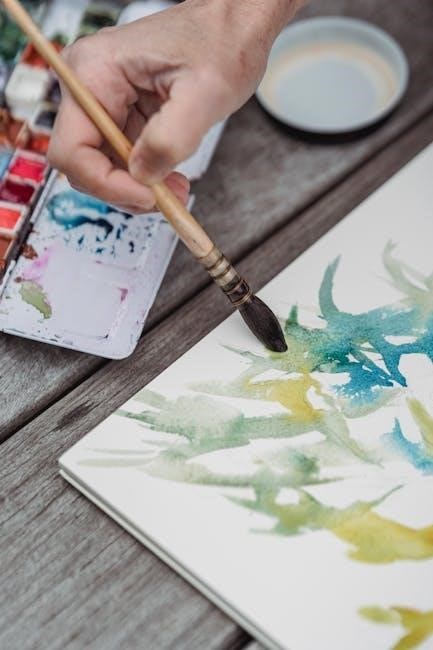
Benefits of Art Therapy for Mental Health
Art therapy fosters mental well-being by empowering self-expression, reducing emotional barriers, and promoting personal growth. It enhances coping mechanisms and provides a non-verbal outlet for processing emotions, aiding overall mental health.
Reducing Stress and Anxiety
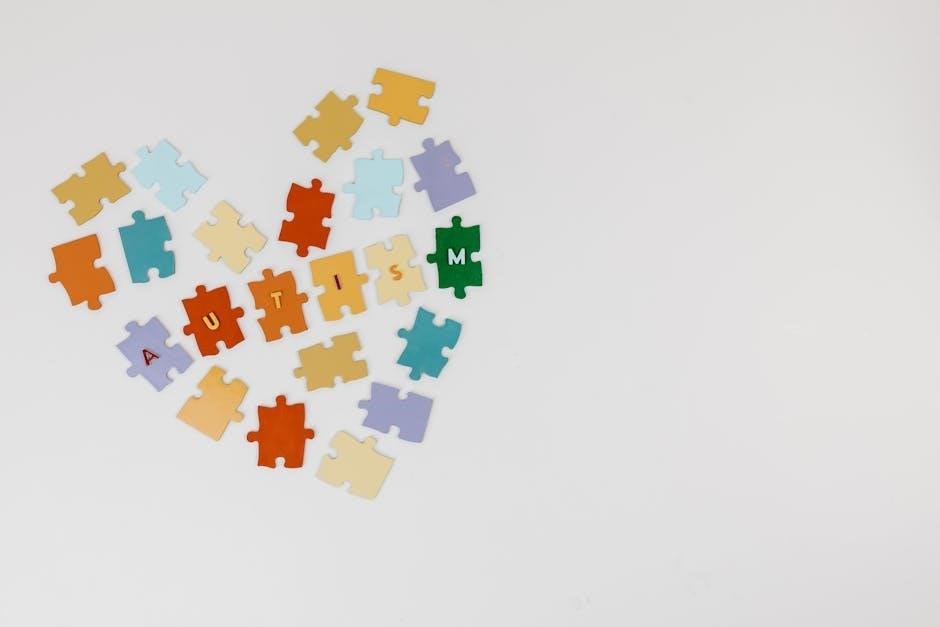
Printable art therapy activities provide a calming and creative outlet for managing stress and anxiety. By engaging in structured exercises, individuals can channel overwhelming emotions into meaningful art, fostering relaxation. The repetitive motions involved in activities like drawing or coloring can induce a meditative state, reducing tension and promoting mindfulness. These exercises allow participants to express feelings non-verbally, offering a safe space to process emotional overload. The portability of PDF resources makes them accessible anytime, enabling consistent practice and emotional release. Through creative expression, art therapy helps diminish anxiety by providing a sense of control and accomplishment, empowering individuals to navigate challenging emotions effectively.
Improving Self-Esteem
Printable art therapy activities play a significant role in improving self-esteem by providing individuals with opportunities for creative expression and personal growth. Through structured exercises, participants can achieve small, measurable successes, boosting their confidence and sense of accomplishment. Activities like collages or drawings allow individuals to reflect on their strengths and positive traits, fostering a more compassionate self-view. The process of creating art encourages self-reflection and validation, helping individuals recognize their worth and capabilities. These exercises empower people to embrace their uniqueness and build resilience, making them invaluable tools for enhancing self-esteem and overall mental well-being.
Fostering Emotional Expression
Printable art therapy activities serve as powerful tools for fostering emotional expression, enabling individuals to communicate feelings that may be difficult to articulate verbally. These exercises provide a safe and creative outlet for exploring complex emotions, allowing participants to process and understand their inner experiences. Activities such as drawing emotions or creating symbolic representations of feelings encourage individuals to externalize their thoughts, gaining clarity and relief. The structured nature of these exercises helps individuals navigate their emotional landscapes, promoting self-awareness and emotional regulation. By engaging in these creative processes, individuals can express themselves authentically, fostering a deeper connection to their emotions and enhancing their overall emotional well-being.
Popular Printable Art Therapy Activities for Adults
Printable art therapy activities for adults include exercises like Mosaic of Self, Landscape of Emotions, Cosmic Voyage, Collage of Dreams, and Nature’s Imprint. These creative tools encourage self-discovery and emotional healing through structured, engaging art-making processes.
Mosaic of Self: A Journey of Reconstruction and Renewal
The Mosaic of Self activity is a powerful tool for self-discovery and emotional healing. Participants create a visual representation of their identity by assembling fragmented imagery and colors, symbolizing personal growth and renewal. This exercise encourages individuals to explore their inner world, reflecting on past experiences, present feelings, and future aspirations. By piecing together disparate elements, users gain insights into their complexities and strengths, fostering self-awareness and acceptance. The process mirrors the reconstruction of one’s sense of self, offering a therapeutic outlet for processing emotions and embracing change. This activity is particularly effective for those seeking to heal from trauma or transition, providing a creative pathway to wholeness and empowerment.
Landscape of Emotions
The “Landscape of Emotions” activity invites participants to create a visual representation of their emotional state through art. By using colors, symbols, and imagery, individuals map their feelings onto a metaphorical landscape, exploring inner worlds and emotional terrains. This exercise encourages introspection, helping users identify and process complex emotions. The process allows for the expression of feelings that may be difficult to articulate verbally, fostering clarity and understanding.
Engaging with this activity can lead to emotional release and insight, as participants visually navigate their emotional landscapes. It is particularly effective for those seeking to manage anxiety, stress, or overwhelming emotions, offering a therapeutic outlet for self-reflection and healing.
Cosmic Voyage
The “Cosmic Voyage” activity invites participants to embark on a visual journey through space, creating a vibrant representation of their inner world. Using colors, patterns, and symbolic elements, individuals craft a celestial landscape that reflects their thoughts, hopes, and emotions. This exercise encourages exploration of the self and the universe, fostering a sense of connection and wonder.
By engaging in this creative process, users can express feelings of awe, curiosity, or even existential reflections. The activity serves as a therapeutic tool for self-discovery, allowing individuals to tap into their imagination and explore deeper aspects of their psyche in a safe and artistic manner.
Collage of Dreams
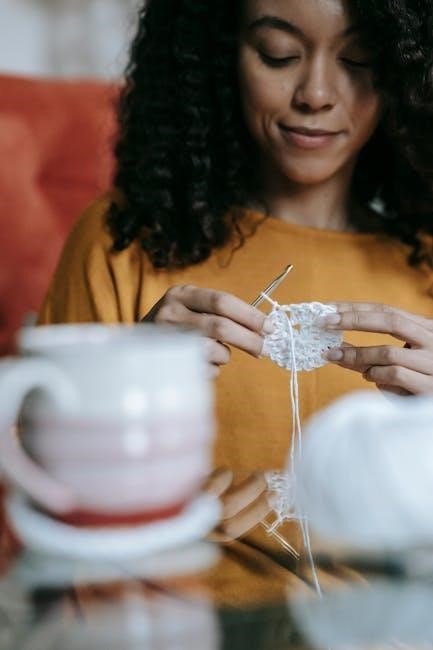
The “Collage of Dreams” activity is a therapeutic exercise designed to help individuals express their thoughts, emotions, and experiences through visual representation. By creating a collage, participants can explore their subconscious mind and bring their innermost feelings to the surface.
This activity involves selecting images, colors, and symbols that resonate with personal experiences or desires. The process encourages self-reflection and creative expression, allowing users to communicate emotions that may be difficult to articulate verbally. It serves as a powerful tool for self-discovery and emotional healing, providing a safe space to process complex feelings and gain insight into one’s inner world.
Nature’s Imprint
Nature’s Imprint is a therapeutic activity that invites individuals to explore their connection with the natural world through art. By creating imagery inspired by nature, participants can express feelings of calm and harmony, fostering a sense of balance in their lives.
This activity encourages the use of natural elements or symbols, allowing individuals to reflect on their relationship with the environment. It provides a creative outlet for processing emotions and gaining insight into personal experiences. The printable format makes it accessible for both individual and group therapy settings, offering a calming and grounding experience for emotional well-being.
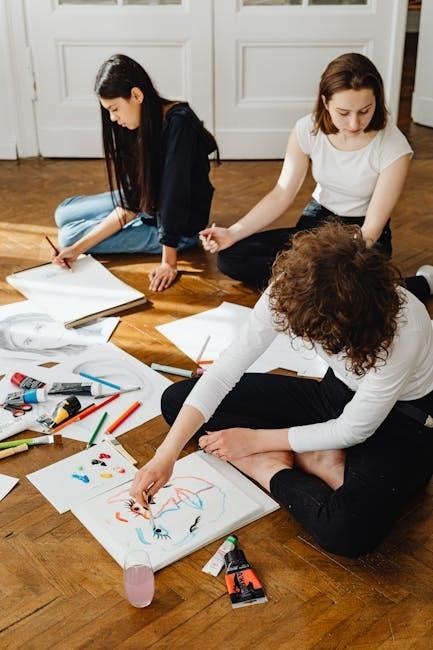
Printable Art Therapy Worksheets for Children
Printable art therapy worksheets for children provide engaging tools for emotional expression and self-awareness. Activities like drawing emotions and identifying things they care about encourage creativity and personal growth.
Expressing Emotions Through Drawing
Expressing emotions through drawing is a powerful tool for children to communicate feelings they may struggle to articulate verbally. Printable art therapy activities provide structured yet flexible exercises, allowing kids to explore their emotions in a safe and creative space. Worksheets often include prompts like drawing how they feel today or illustrating a happy memory. These activities help children identify and process their emotions, fostering self-awareness and emotional intelligence. By using colors, shapes, and imagery, children can convey complex feelings in a way that is both intuitive and therapeutic. This method is particularly effective for younger children who may not yet have the language to express their emotions effectively. Regular practice can lead to improved emotional regulation and overall well-being, making it a valuable addition to any therapeutic or educational setting. Additionally, these exercises encourage creativity and provide a sense of accomplishment as children see their thoughts and feelings take form on paper.Overall, drawing offers a non-verbal outlet for emotional expression, helping children navigate their inner world with greater ease and understanding.
Identifying Things They Care About
Helping children identify things they care about is a key aspect of art therapy, fostering self-awareness and a sense of purpose. Printable worksheets often feature exercises where kids draw or list elements important to them, such as family, pets, or hobbies. These activities encourage reflection and provide insight into their values and interests. By visually representing what they care about, children can better understand their own priorities and emotions. This process also enhances communication skills, allowing them to articulate their thoughts more clearly. Additionally, these exercises can reveal patterns or themes that are meaningful to their personal growth. Overall, identifying things they care about through art therapy helps children build a stronger connection with their inner selves and the world around them. This practice supports emotional development and resilience.
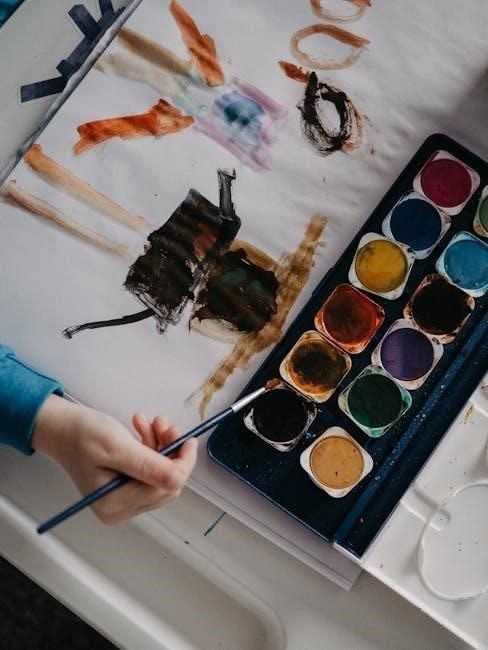
Art Therapy Activities for Specific Mental Health Conditions
Printable art therapy activities are tailored to address specific mental health conditions like PTSD and anxiety. These exercises provide structured ways to process emotions and promote healing through creative expression, offering targeted support for diverse mental health needs.
Activities for PTSD

Printable art therapy activities for PTSD offer a creative outlet for processing trauma and emotions. These exercises, such as creating a “safe space” or “trauma timeline,” help individuals visually express their experiences. Grounding techniques, like drawing nature scenes, can reduce symptoms and promote emotional regulation. Structured prompts guide participants in exploring memories and feelings, fostering a sense of control and empowerment. These activities provide a non-verbal way to confront and heal from traumatic events, making them an effective tool in PTSD recovery. By focusing on creativity, individuals can transform painful memories into meaningful expressions, aiding in their therapeutic journey and personal growth.
Exercises for Anxiety Relief
Printable art therapy activities for anxiety relief provide calming and structured exercises to manage stress and promote relaxation. Techniques like mandalas, abstract art, and body scan drawings help individuals focus on creativity rather than anxiety. These exercises encourage mindfulness, allowing participants to express and release tension through art. By creating visually soothing patterns or exploring emotions symbolically, individuals can regain a sense of control and reduce overwhelming feelings. These tools are versatile, offering immediate stress relief and fostering a sense of accomplishment. They empower individuals to navigate anxiety creatively, making them an essential part of mental health practices. Regular practice can lead to lasting emotional well-being and resilience.
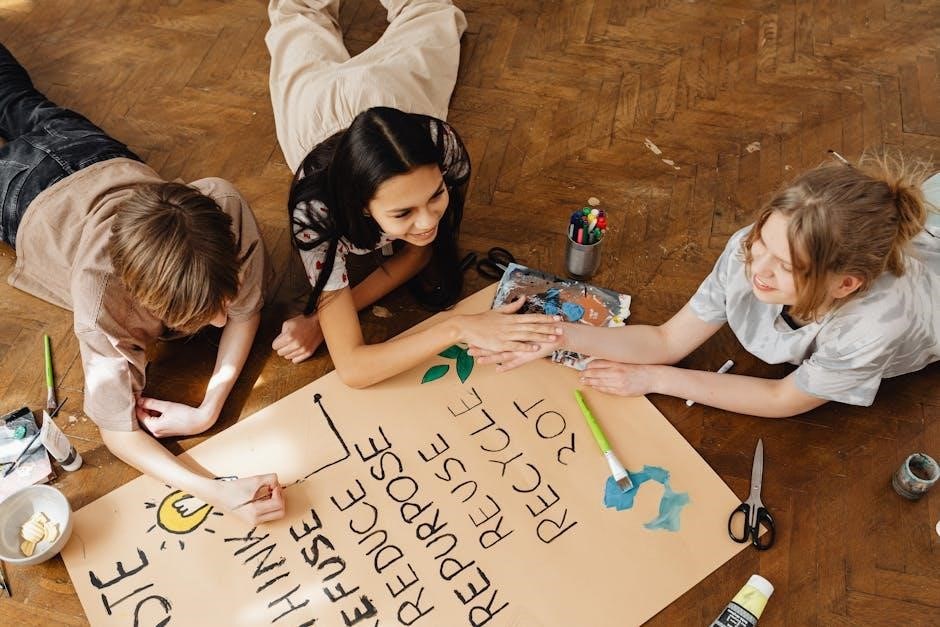
How to Use Art Therapy Worksheets Effectively
Guided prompts and structured exercises enhance creativity, fostering emotional exploration. Balancing direction with freedom allows individuals to express feelings deeply, promoting therapeutic breakthroughs and engagement in the process.
Individual vs. Group Therapy Settings
Printable art therapy activities can be tailored to both individual and group settings, offering flexibility for diverse therapeutic needs. In individual therapy, worksheets allow for personal reflection and customization, enabling clients to explore their emotions privately. This setting is particularly beneficial for those who may feel hesitant to share their feelings in a group environment. On the other hand, group therapy settings foster collaboration and shared experiences, encouraging participants to learn from one another and build a sense of community. Group activities often involve collaborative art projects or discussing individual creations, which can enhance empathy and understanding among participants. Both settings leverage the therapeutic benefits of art, providing a safe space for emotional expression and growth.)
Guided Prompts for Creativity
Guided prompts in printable art therapy activities serve as powerful tools to ignite creativity and focus. These prompts provide clear directions while allowing individuals to interpret and express their emotions uniquely. For example, exercises like “Create a Safe Space” or “Visualize Your Emotional Landscape” encourage participants to explore personal themes. Such structured yet flexible prompts help individuals navigate their thoughts and feelings without feeling overwhelmed. They also offer a sense of accomplishment as clients complete each task, fostering motivation and engagement. Whether used in individual or group settings, guided prompts enhance the therapeutic experience by bridging creativity and emotional exploration, making art therapy accessible and meaningful for all participants. These prompts are especially effective in helping individuals build confidence and tap into their inner creative potential.

Printable art therapy activities offer a transformative tool for emotional healing and self-expression. They empower individuals to explore their feelings creatively, fostering growth and well-being in an accessible way.

Final Thoughts on Printable Art Therapy
Printable art therapy activities provide a powerful, accessible tool for emotional expression and healing. They empower individuals to explore their inner worlds creatively, fostering self-discovery and personal growth. With a wide range of exercises available, from mandalas to collages, these resources cater to diverse needs and skill levels. Whether used at home or in professional settings, printable art therapy activities offer a cost-effective and convenient way to engage in therapeutic practices. By encouraging consistent creative practice, they help individuals process emotions, gain insights, and cultivate a sense of calm and fulfillment. This accessible form of therapy makes it easier for anyone to embrace creativity as a pathway to mental and emotional well-being, inspiring confidence and fostering a deeper connection to oneself.
Encouraging Continued Creative Practice
Printable art therapy activities serve as a valuable resource for fostering ongoing creative engagement. By providing accessible and convenient tools, they encourage individuals to embrace art-making as a regular practice. These exercises, such as mandalas or collages, are designed to be both enjoyable and achievable, helping to build confidence and motivation. Regular creative practice can lead to deeper emotional awareness and personal growth. Whether used at home or in therapeutic settings, these activities offer a sustainable way to nurture mental and emotional well-being. The variety of exercises ensures that individuals can explore different aspects of their creativity, keeping the practice fresh and engaging over time. This consistent engagement with art therapy can lead to profound, long-lasting benefits for mental health and self-expression.
